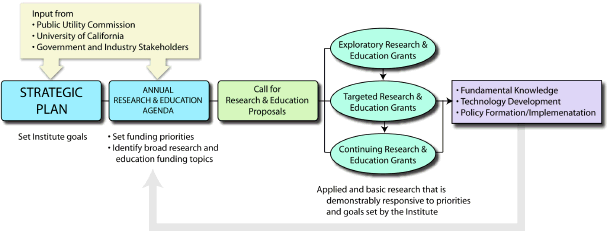2. Organizational Structure and Governance
2.a. Governance and Administration
The CICS will be a dynamic research and educational partnership between the University of California, the PUC, and other stakeholders. Working together, this group will strategically develop and pursue a research and educational agenda that transcends individual interests and priorities. This necessarily requires an organizational structure that is able to (1) seamlessly integrate policy, science, and technology; (2) sustain efforts over an extended period; and (3) maintain a nimbleness that allows it to shift emphasis to immediate or critical problems as they arise.
A master agreement between the UC and PUC will allow for the efficient deployment of both short- and long-term task orders to undertake specific projects or respond to policy analysis requests. Task orders have been used successfully on several campuses and facilitate inter-campus agreements, allow expedited processing of time sensitive topics and provide an on-going mechanism in support of a regular consultative process. In general, task orders will be issued for projects identified and supported through the proposal process and headed by researchers with expertise in the principal area required by the individual task orders; project durations will range from a short period (e.g., a few months for expert reviews or analysis) to as long as several years. The structure of the CICS will also allow for periodic external peer review and reassessment of overall priorities and goals.
The task-order mechanism will also fund, through cost-sharing agreements, the CICS's engagement with state municipalities, agencies, and the private sector in part through a parallel program of internship opportunities and visiting staff periods. In this way, the mission-oriented efforts of the Institute will support not only industry, government, and university professionals, but also researchers at all levels of the UC, from undergraduate to post-doctoral. These exchanges will serve several goals: (1) provide educational instruction or mentoring in the CICS's areas of active work; (2) engage professionals from the public or private sector in specific program areas, or in the design or implementation of programmatic aspects of the mission of the Institute; and (3) provide opportunities for officials from agencies or industries outside California to participate in the development of technologies, programs, and policies to address climate change.
The Institute Director, in collaboration with the Steering Committee and Stakeholder Committee (described below), will prepare a 3-5 year strategic plan that establishes broad goals (Figure 1). The strategic plan will guide the development of an annual research and educational agenda, which will be collaboratively prepared with researcher and stakeholder input. The annual research and education agenda will identify short- and long-term priorities and broad research and educational funding topics. Once the research and education agenda is published, there will be an annual call for proposals falling into three categories: i) exploratory grants, which will fund short-term, higher-risk ideas; ii) larger, targeted grants, which will fund longer-term efforts and comprise over 2/3 of the program; and iii) continuing grants, which will be used to extend productive areas of research and education for an additional year or two. Both research and education proposals may be submitted for each of these categories. Partnerships with industry, non-UC research and educational institutions, and other stakeholders (e.g., NGOs) will be sought, where possible, to complement and extend research and educational objectives. Funded efforts in every category must include societal applications such as technology development, insight into policy implementation or analysis, and/or fundamental knowledge. All submitted proposals will undergo external review by a panel made up of both academics and stakeholders.

Figure 1. Organizational Process of the California Institute for Climate Solutions
2.b. Leadership
The CICS will be led by the Institute Director, who will report to the Governing Board and receive programmatic guidance and support from several key committees. The Steering Committee and Stakeholder Committee will provide broad programmatic direction to the CICS, and will represent the interests of the UC, PUC, and other stakeholders. The Program Council will assist the Director in ongoing activities regarding the conduct of research and education programs. The organizational structure is outlined in Figure 2.
Governing Board. The Governing Board will be co-chaired by the PUC President and the UC President, and will include additional senior personnel from each institution, and other state organizations and external experts. The Board will reflect shared governance over the strategic mission of the CICS and approve the strategic plan. The Governing Board will establish the Institute's mission, and appoint the members of the Steering and Stakeholder Committees. It will oversee a regular review of program activities by internationally renowned experts unaffiliated with the Institute.



